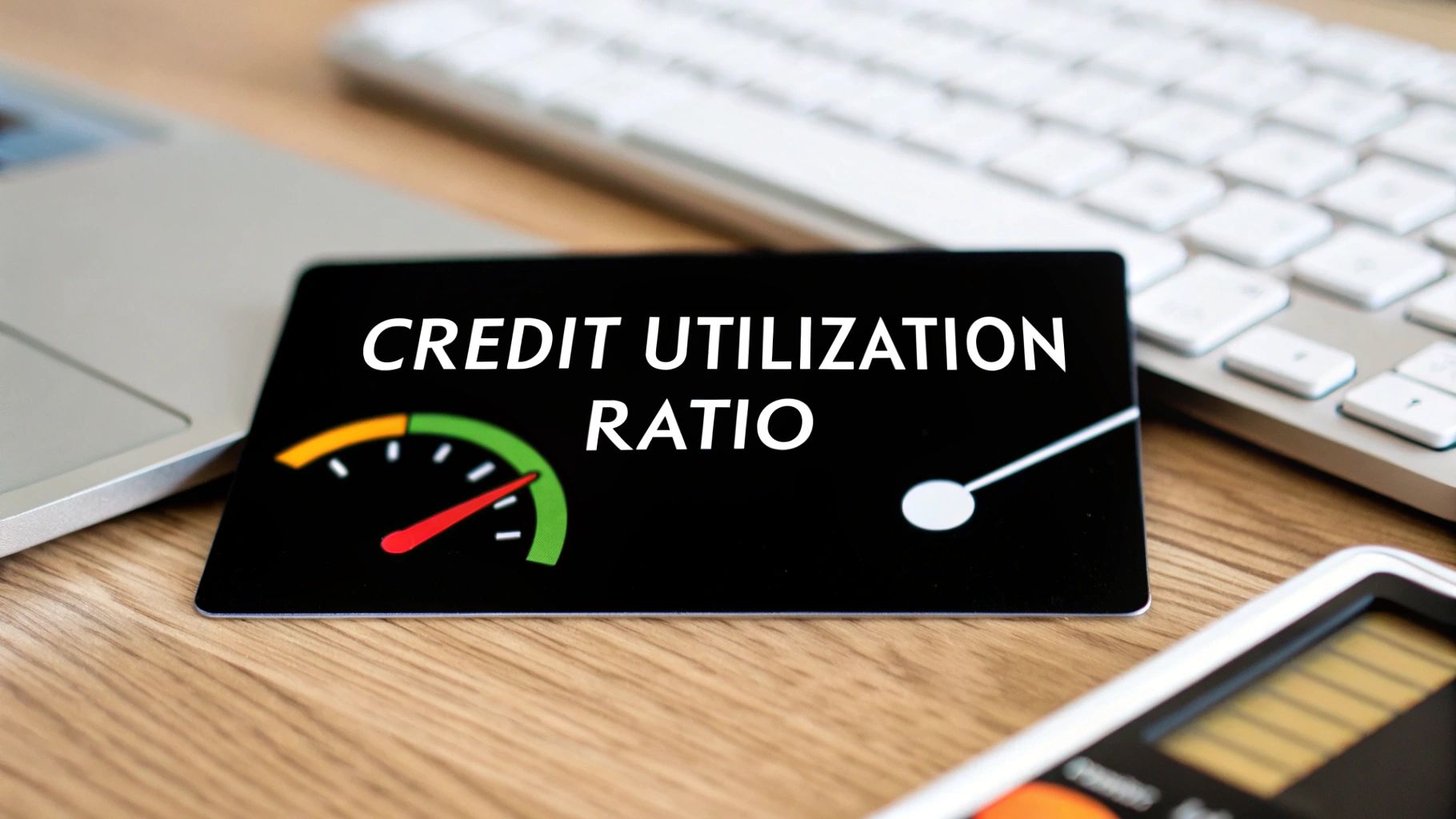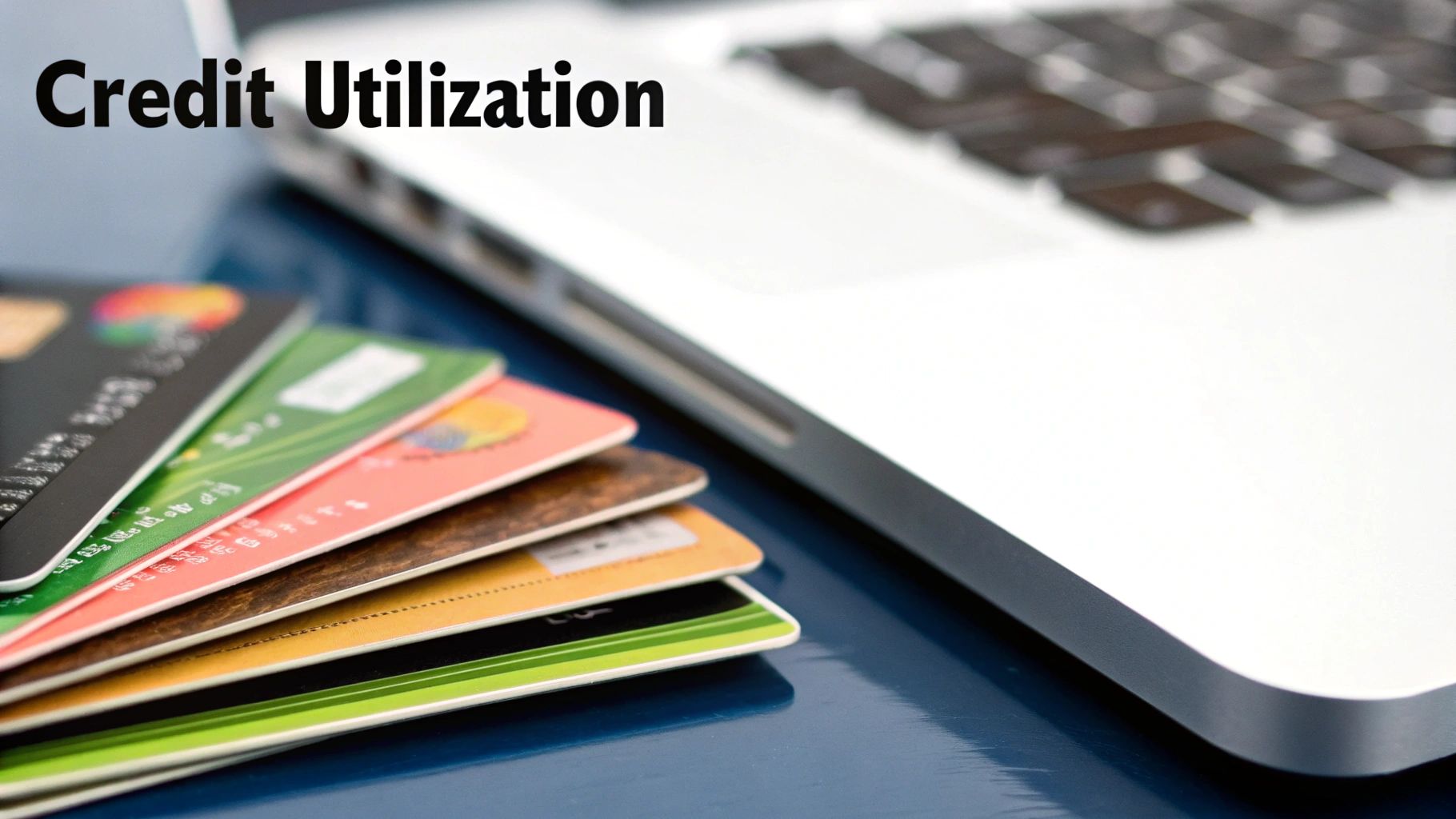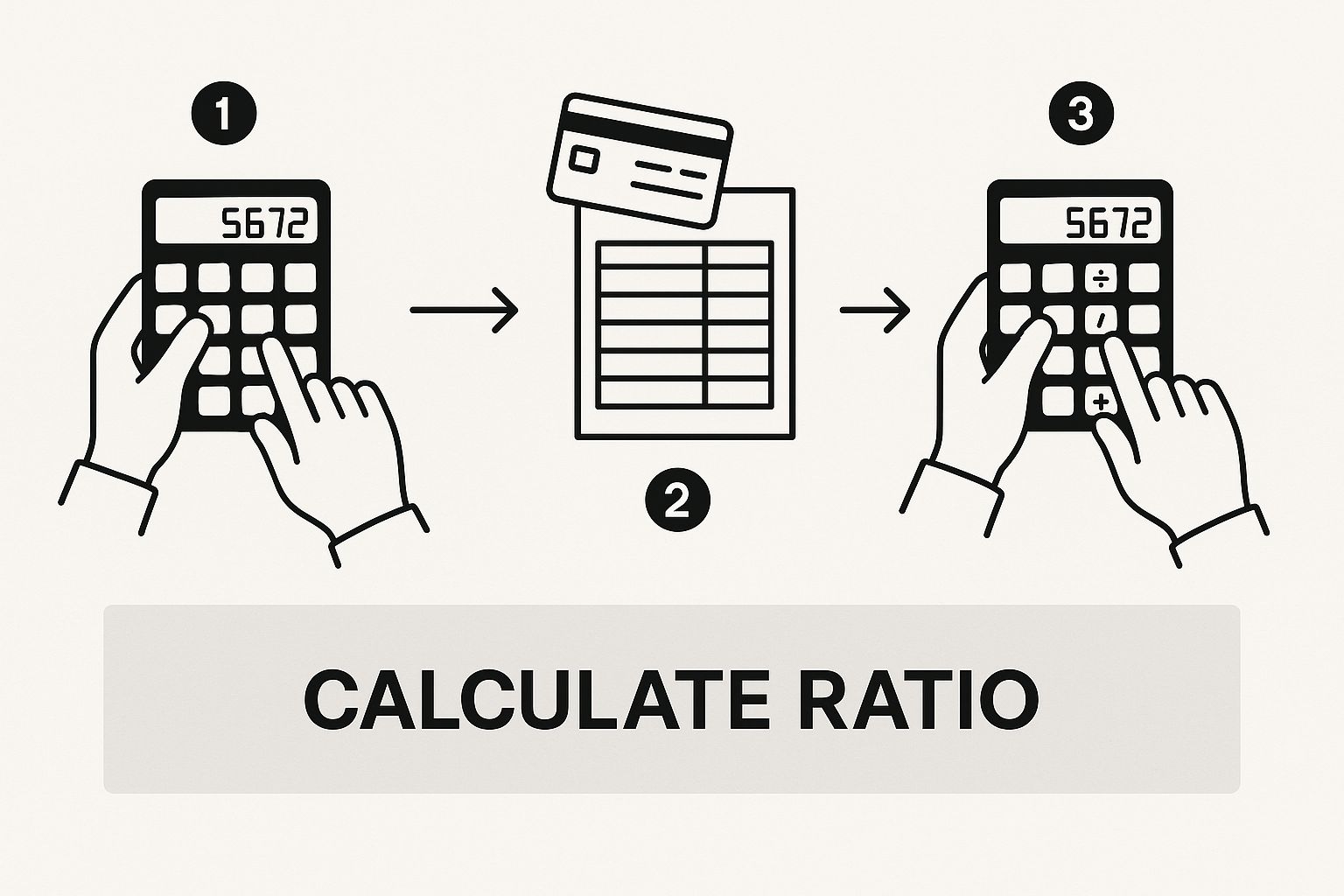What Is a Credit Utilization Ratio? Improve Your Credit Score

Let's talk about one of the most powerful, yet often misunderstood, numbers in your financial life: your credit utilization ratio. It's a simple percentage that shows how much of your available credit you're actually using at any given moment.
Think of it like a gas gauge for your credit health. A full tank (low utilization) signals you have plenty of resources, while a needle hovering on empty (high utilization) might make lenders nervous.
What is a Credit Utilization Ratio?

At its core, your credit utilization ratio is a key metric lenders use to gauge how well you manage debt. It focuses specifically on your revolving credit accounts—the kind where you can borrow, repay, and borrow again up to a certain limit.
The most common examples of revolving credit are:
It's just as important to know what doesn't count here. Your installment loans—things like your mortgage, car loan, or student loans—have fixed payments and aren't part of this calculation.
Why Lenders Care So Much
Lenders look at your credit utilization as a real-time snapshot of your financial habits. A low ratio tells them you use credit as a tool, not a crutch, and that you have a healthy financial cushion.
On the other hand, a high ratio can be a red flag. It might suggest you're overextended and could struggle to make payments if you hit a rough patch.
This ratio is so influential because it’s constantly changing. Every time your card issuers report your balance to the credit bureaus (usually monthly), your utilization can shift. This gives you a fantastic opportunity to actively manage and improve it. By understanding what a credit utilization ratio is and how it’s viewed, you can take control of a huge piece of your credit score.
To make this crystal clear, here’s a quick breakdown of the moving parts.
Credit Utilization at a Glance
This table breaks down the key components and ideal levels of your credit utilization ratio.
Understanding these three elements is the first step toward mastering your credit health.
How Credit Utilization Impacts Your Financial Life
Your credit utilization ratio is more than just a number on a report. Think of it as a signal you're constantly sending to lenders, landlords, and anyone else who looks at your credit. This one percentage carries a lot of weight and directly affects your ability to get a loan, a new credit card, or even that apartment you want.
Simply put, lenders see it as a key measure of how you handle your finances. A low ratio tells them you’re managing your debt well and not leaning too heavily on credit. A high ratio, on the other hand, can be a major red flag, suggesting you might be stretched too thin and could be a risky borrower.
The Connection to Your Credit Score
When it comes to your credit score, your utilization is a huge piece of the puzzle. It's the second most important factor, right behind paying your bills on time.
This powerful connection also means it's one of the fastest ways to give your score a boost. Building a long credit history takes years, but you can see a positive change in your utilization—and your score—in as little as a month.
Real-World Financial Opportunities
A good credit utilization ratio does more than just give you a nice credit score; it opens up real, tangible financial opportunities. Keeping your ratio low can lead to some serious perks:
At the end of the day, mastering your utilization ratio is a fundamental step toward achieving what is considered a good credit score and building the financial future you want. It’s a key that unlocks better opportunities and greater financial freedom.
Don't just understand what your credit utilization ratio is—learn how to figure it out for yourself. It’s not as complicated as it might sound. In fact, it's simple arithmetic that gives you a crystal-clear snapshot of your credit health.
Knowing this number puts you in the driver's seat. Here’s how you can calculate it in 3 simple steps.
The 3-Step Calculation Process
This handy visual breaks it down even further, showing just how simple it is to plug in your own numbers.

As you can see, all you really need is a calculator and a few minutes to find this crucial number.
Let's Look at a Real-World Example
Putting it into practice makes it even clearer. Let’s say you have two credit cards in your wallet:
First, we'll combine the balances: 500 + 1,000 gives you a total balance of $1,500.
Next, we'll add up the credit limits: 4,000 + 6,000 equals a total available credit of $10,000.
Finally, we just divide the total balance by the total limit and multiply by 100: (1,500 / 10,000) * 100 = 15%.
In this scenario, your overall credit utilization ratio is a very healthy 15%. Lenders really like to see this number stay below 30%, because anything higher can look like you're overextended and might be a risk.
Once you know your number, you can start taking steps to improve it. For a more detailed breakdown of the math, check out our guide on how to calculate credit utilization.
Seeing the Real-World Impact of Your Ratio
Alright, let's move past the theory. Understanding the math is one thing, but seeing how your credit utilization ratio actually affects someone's life is where the lightbulb really goes on. To bring this home, let’s look at two people in very different situations.
First up is Sarah. She's smart with her money and makes a point to keep her credit card balances low. Her total credit limit across all her cards is 20,000**, and she consciously keeps her total balance around **1,800. This simple habit puts her credit utilization at a fantastic 9%.
Then we have Steve. He’s found himself leaning on his credit cards to bridge financial gaps, and the balances have piled up. He has the same 20,000** total credit limit as Sarah, but his combined balances have climbed to **17,000. That puts his utilization at a sky-high 85%.
Low vs High Credit Utilization: A Financial Snapshot
The gap between Sarah’s 9% and Steve’s 85% is more than just a number on a report—it shapes their entire financial reality. The table below paints a clear picture of just how different their day-to-day lives are because of this one metric.
As you can see, Sarah’s low utilization acts like a key, unlocking better financial products and giving her peace of mind. Lenders see her as a safe bet and roll out the red carpet with their best offers.
For Steve, that high ratio is a massive roadblock. Lenders see him as overextended and risky, shutting the door on new credit when he needs it most. It's a tough cycle of high debt and high interest that can be incredibly hard to escape. Their stories are a powerful reminder of what a credit utilization ratio truly means for your financial well-being.
Proven Strategies to Lower Your Credit Utilization

Knowing your credit utilization ratio is one thing, but actually improving it is where you can make a real difference to your financial health. The most straightforward way, of course, is to pay down your balances. But there are other smart tactics you can use to manage the numbers that get reported to the credit bureaus.
One of the most powerful tricks in the book is making payments before your statement closing date. Most people don't realize that credit card issuers usually report your balance to the bureaus just once a month, right after your statement closes. By paying off a big piece of your balance a few days before that date, the number that gets reported is much lower. This simple move can drop your utilization percentage almost immediately.
Strategic Moves for Your Credit Profile
Besides just timing your payments, you can also tackle the other side of the utilization equation: your total available credit.
Here are a couple of ways to do that:
If you’re ready to get more hands-on, you can explore more advanced credit utilization tips that cover everything from balance transfers to managing multiple cards. These proven methods give you a clear roadmap to a healthier credit profile and a better score.
A Few Lingering Questions About Credit Utilization
Even once you have the basics down, a few tricky questions about credit utilization can pop up. Let's clear up some of the most common ones so you can manage your credit with total confidence.
Does Closing an Unused Credit Card Hurt My Score?
More often than not, yes. It might seem counterintuitive, but closing an old, unused card can actually make your credit score dip.
Think back to the utilization formula. When you close an account, you instantly erase that card's credit limit from your total available credit. If you're carrying balances on your other cards, your overall utilization ratio will immediately shoot up, and your score will likely drop as a result.
Unless the card comes with a hefty annual fee you just can't justify anymore, it’s usually better to keep it open. That old account with a zero balance is a quiet hero—it helps keep your utilization low and also boosts the average age of your credit history.
How Often Is My Credit Utilization Updated?
Most credit card issuers report your balance and limit to the big three credit bureaus (Equifax, Experian, and TransUnion) once every month. This usually happens right after your statement closing date.
Is a 0% Utilization Ratio the Best I Can Do?
Surprisingly, no. While a 0% ratio is a world away from a high one, some scoring models actually like to see a tiny bit of activity—somewhere in the 1-9% range—rather than nothing at all.
Why? A small balance that you pay off in full every month shows lenders you're actively and responsibly managing your credit, which they love to see. The golden rule is to always stay well below the 30% mark. For an excellent score, aiming for under 10% is the sweet spot. It proves you have access to credit but don't need to depend on it.